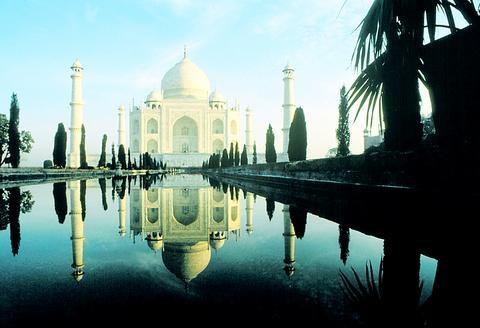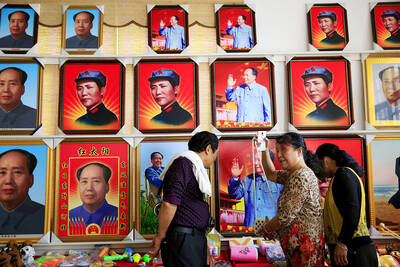The Taj Mahal, with all its wonder and majesty, is not the only spot in Agra resplendent in elegance. Heirs of craftsmen carry on traditions in jewelry, brassware and inlaid marble, but a showroom displaying the unique embroideries of the late Shams Uddin offers a spellbinding presentation of the works by the innovative artist.
Awarded the "Padma Shri" on Jan. 26, 1989 by the government of India, a distinction comparable to a knighthood, Shams is hailed as the originator of embroidery in three dimensions.

PHOTO: DPA
His creations over more than three decades reflect such startling realism and brilliant colors the subjects, primarily wildlife, appear ready to amble out of their frames.
"I didn't know there was anything else to see in Agra except the Taj Mahal," said American tourist Janet Grove. "This type of artistry astounds me."
There is no admission charge. "Everyone is welcome," said Ghanshyam Mathur, noting explanations are available in English, German, French, Spanish, Italian and Indian dialects.
Entering a large room plunged into darkness, light suddenly focuses on a huge hanging embroidery of a bouquet of flowers seemingly hanging into the room from a vase embedded with semi-precious stones.
Measuring 2.13m by 1.52m, the work took the artist 4,170 days to complete, said Mathur, who guides visitors through the collection. None of the embroideries displayed, supplied by his family, are for sale. Shams, who died in 1999 at the age of 86, "was a naturalist," Mathur said.
Maximizing the dramatic effect is the light focused only on a single piece at a time. The gold and silver incorporated in one embroidery amount to 27,000 carats. Among the 23 wildlife scenes in silk threads is a large-scale embroidery of fighting cocks in dazzling hues that occupied Shams for 1,475 days, a stalking Indian tiger requiring 620 days and 21 other wildlife scenes, all made by hand.
A cheetah hunting partridges and a lioness bringing down an African zebra portray with stark vividness the realities of life in the wild.
In contrast, there are also works conveying the serenity of African elephants enjoying an evening drink, peacocks playing, parakeets alighting on a branch and Arabian stallions running through the plains.
Shams made "free hand sketches of his subjects," explained Mathur. Working alone, he embroidered them in cotton threads over and over until he obtained the required thickness and movements. Then, he took fiber from silk threads and twisted them together in the shades required.
"In the process, he created original unparallel works of art," Mathur said.
A long list of dignitaries have praised Shams' masterpieces. The first president of India, the late Rajendra Prasad, and the first prime minister, the late Pandit Jawahar Lai Nehru visited his exhibition in 1960. Shams embroidered the official seal of the president of the US and presented it to Lyndon Johnson in 1966. It is currently in the deceased president's library.
A portrait of late president Abraham Lincoln was turned over to former president Gerald Ford in 1976 and placed in the National Archives. Britain's Prince Charles was another recipient of a Shams' creation on visiting Agra in 1980. He was also honored with a special award by the late Prime Minister of India Indira Gandi.
A Hindu, Shams also respected figures from other religions, evident in his portrayal of Jesus surrounded by sheep in a pastoral setting embroidery called the Good Shepherd. The large embroidery required 6,570 days and is comparable in size to the figure of Lincoln. Viewers awed by the tapestries, each in its special glass case, are also amazed at the abundance of gemstones numbering in the thousands, including rubies, amethysts, garnets, topaz and an array of others.
Many of the stones were donated to Shams by the Kohinoor Jewellers adjacent to the showroom, Mathur said.
The single edifice captured on the embroideries on show is the Taj Mahal. The elaborate tribute to the wife of Emperor Shan Jahan after she died in childbearth in 1631 is depicted by Shams in white as it is seen in the brilliance of midday.
Equisite symmetry and harmony are the keynotes of the tapestry, as they are of the world-renowned mausoleum.
Although nearly blind in his later years, Shams continued his work, relying on family members to help him recreate in three dimensions his beloved subjects.
The technique is carried on now by his sons and other relatives, working out of their homes.

Taiwan can often feel woefully behind on global trends, from fashion to food, and influences can sometimes feel like the last on the metaphorical bandwagon. In the West, suddenly every burger is being smashed and honey has become “hot” and we’re all drinking orange wine. But it took a good while for a smash burger in Taipei to come across my radar. For the uninitiated, a smash burger is, well, a normal burger patty but smashed flat. Originally, I didn’t understand. Surely the best part of a burger is the thick patty with all the juiciness of the beef, the

The ultimate goal of the Chinese Communist Party (CCP) is the total and overwhelming domination of everything within the sphere of what it considers China and deems as theirs. All decision-making by the CCP must be understood through that lens. Any decision made is to entrench — or ideally expand that power. They are fiercely hostile to anything that weakens or compromises their control of “China.” By design, they will stop at nothing to ensure that there is no distinction between the CCP and the Chinese nation, people, culture, civilization, religion, economy, property, military or government — they are all subsidiary

This year’s Miss Universe in Thailand has been marred by ugly drama, with allegations of an insult to a beauty queen’s intellect, a walkout by pageant contestants and a tearful tantrum by the host. More than 120 women from across the world have gathered in Thailand, vying to be crowned Miss Universe in a contest considered one of the “big four” of global beauty pageants. But the runup has been dominated by the off-stage antics of the coiffed contestants and their Thai hosts, escalating into a feminist firestorm drawing the attention of Mexico’s president. On Tuesday, Mexican delegate Fatima Bosch staged a

Would you eat lab-grown chocolate? I requested a sample from California Cultured, a Sacramento-based company. Its chocolate, not yet commercially available, is made with techniques that have previously been used to synthesize other bioactive products like certain plant-derived pharmaceuticals for commercial sale. A few days later, it arrives. The morsel, barely bigger than a coffee bean, is supposed to be the flavor equivalent of a 70 percent to 80 percent dark chocolate. I tear open its sealed packet and a chocolatey aroma escapes — so far, so good. I pop it in my mouth. Slightly waxy and distinctly bitter, it boasts those bright,